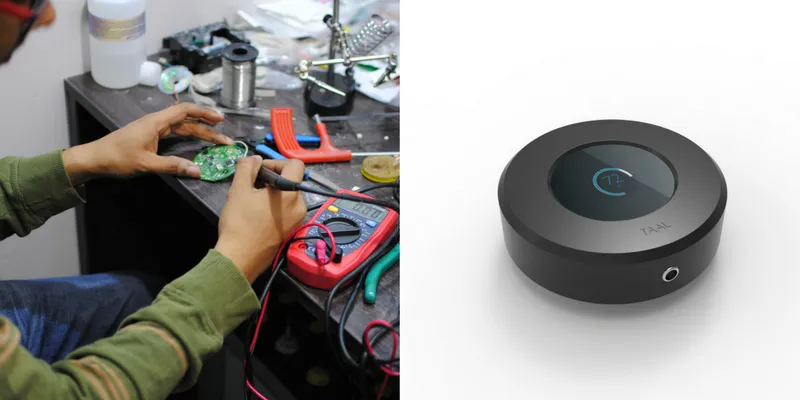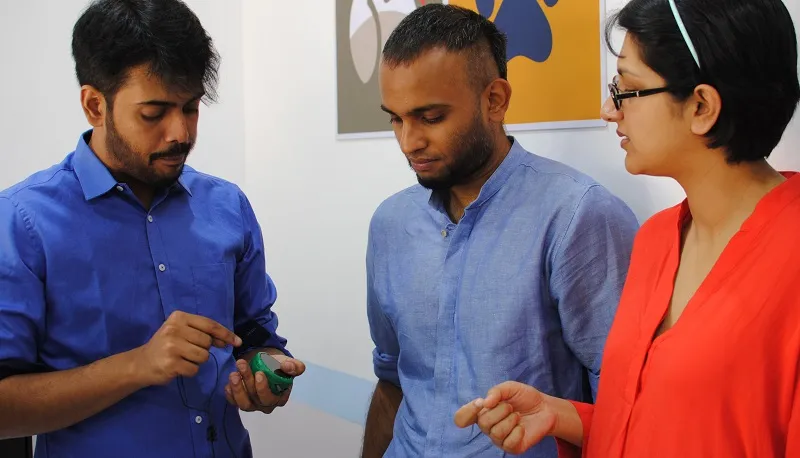When a doctor and an engineer joined hands to build stethoscopes of the future
Arvind Badrinarayanan and Sumukh Mysore have created a digital stethoscope called Taal, that is low-cost and can help healthcare professionals with limited training screen patients easily.

As a veterinary doctor, Arvind Badrinarayanan was used to working in noisy environments. However, all the dog barks and cat squeals made using a stethoscope difficult.
It’s not all that different in human healthcare, he says, It is difficult to find a quiet environment in hospitals and clinics unless they are expensive and private.
Arvind initially started working on a solution for himself, but the more he worked on it, the more he realised that better sound could actually change healthcare.

“When a student learns about sounds in medical school, she learns it through descriptions,” Arvind says, “Unless there are recordings available, you have to rely on terms such as ‘galloping heartbeat’.
I remember how my professors used to say, think of a horse to understand what this means. When these terms were coined, horses were common. But today, these terms are hardly intuitive.
In the absence of sound samples to learn from, a doctor learns only through experience. Was there then, Arvind thought, a way to create a stethoscope that helped you hear better and that could record heartbeats and sounds in the lungs?
Discovering the gap
He teamed up with Sumukh Mysore, a biotechnology engineer and researcher. The two soon discovered that there was no good digital stethoscope in the market despite the obvious demand. “A traditional stethoscope is a primitive device,” Arvind says,
This was obvious to people even a hundred years ago, when they tried to create electronic stethoscopes. However, the costs of developing such a device have been prohibitive until recently. Audio processing is a high-end, intensive process. The technology has become fairly cheap only with the cellphone revolution.
But the cellphone revolution happened long enough ago – why then has the opportunity of creating a cheap digital stethoscope not been exploited? “Stethoscope companies have tried to create very high-end digital stethoscopes, that are targeted towards cardiologists. Since they are for specialists, they use expensive technology to detect the faintest of sounds to diagnose the most obscure diseases. They cost anywhere between 150-300 US dollars, and are not very user-friendly.”
An Indian solution
“We were looking to solve a different problem,” Arvind says,
We are not targeting cardiologists only. We wanted to make a digital stethoscope for all healthcare professionals – doctors, nurses, paramedics – to help them screen patients as part of the primary healthcare system.
And so the duo created Taal, a digital stethoscope priced at 50 US dollars, that helps in the screening stage of healthcare. The screening stage is when a tentative diagnosis is arrived at alongwith some data. Confirming a diagnosis involves expensive tests. In India, the confirmation of diagnosis stage is often skipped.

“There is no reason we should emulate the Western, resource-intensive model,” Arvind says, “Some of the biggest companies that have shown interest in our product have been telemedicine companies, where doctors are given information of basic symptoms, look at a patient’s face, and recommend a treatment. Taal can help a person on the ground record a heartbeat or another such sound, send it to the remote doctor, and help him make a much better diagnosis.”
Their knowledge of music helped them create Taal. Arvind was a mridangam player, and Sumukh was part of a hip hop trio called 'Machas With Attitude'.
Knowing how compression works, what kind of microphone to use – this was knowledge we had through music, Arvind says.
Enabling nurses
Taal has the potential to change the work nurses do.

“Today, it takes fifteen years to become a cardiologist, and an additional 5-10 years to become a respected cardiologist. Among other reasons, it takes so long because only practice makes perfect. One has to hear a lot of heartbeats to make accurate diagnoses. With sounds recorded through a digital stethoscope, you can hear symptoms over and over again. This will dramatically cut down the time it takes to better your craft as a cardiologist.
Most importantly of all, it enables nurses to screen patients through stethoscopes, as they can practice too. It can give our nurses the ability to diagnose what today’s cardiologists can. This is the end goal.
The list of improvements a device like Taal can make is long. It can help doctors share recordings with other doctors much more easily, to improve diagnoses; it can help rural healthcare professionals access a wide variety of material on sound; it can even help test medical students through audio recordings.
Looking ahead
While Taal has multiple eager would-be customers – healthcare professionals and companies from 15 countries and counting – they are currently finding it difficult to find a manufacturer with the appropriate level of precision required to make the device.
We have received our first round of funding, get calls every day from doctors asking if the device is out yet, but had to relook at our manufacturer. We are now working very hard to find the right manufacturer, Arvind says.
“When our parents were growing up,” Arvind says, “Digital thermometers were a rarity, if that. People did not keep one at home. Today, they are commonplace, and parents know how to read them and know when a fever should be shown to a professional. A digital stethoscope can be that – parents can understand when a heartbeat or a sound in the lungs needs to be shown to a doctor. Healthcare is on the cusp of a sound revolution.”







